Strategic HRM: Business Strategy and Employee Relations at Unilever
VerifiedAdded on 2020/10/22
|13
|3912
|446
Report
AI Summary
This report provides a comprehensive overview of Strategic Human Resource Management (SHRM), focusing on its application within Unilever. It examines the relationship between business strategy and HR strategy, emphasizing the importance of aligning these elements to maximize profitability and employee engagement. The report delves into various models of SHRM, including the best-fit, universalistic, and contingency perspectives, and evaluates their relevance to Unilever's operations. Furthermore, it analyzes the nature and theoretical perspectives of employment relations, using the Marxist theory to understand the dynamics between employers and employees. The report concludes with a critical evaluation of different approaches to SHRM, offering recommendations for performance management and employee development within Unilever, such as the adoption of an attributive approach to assess employee contributions and design appraisal plans.
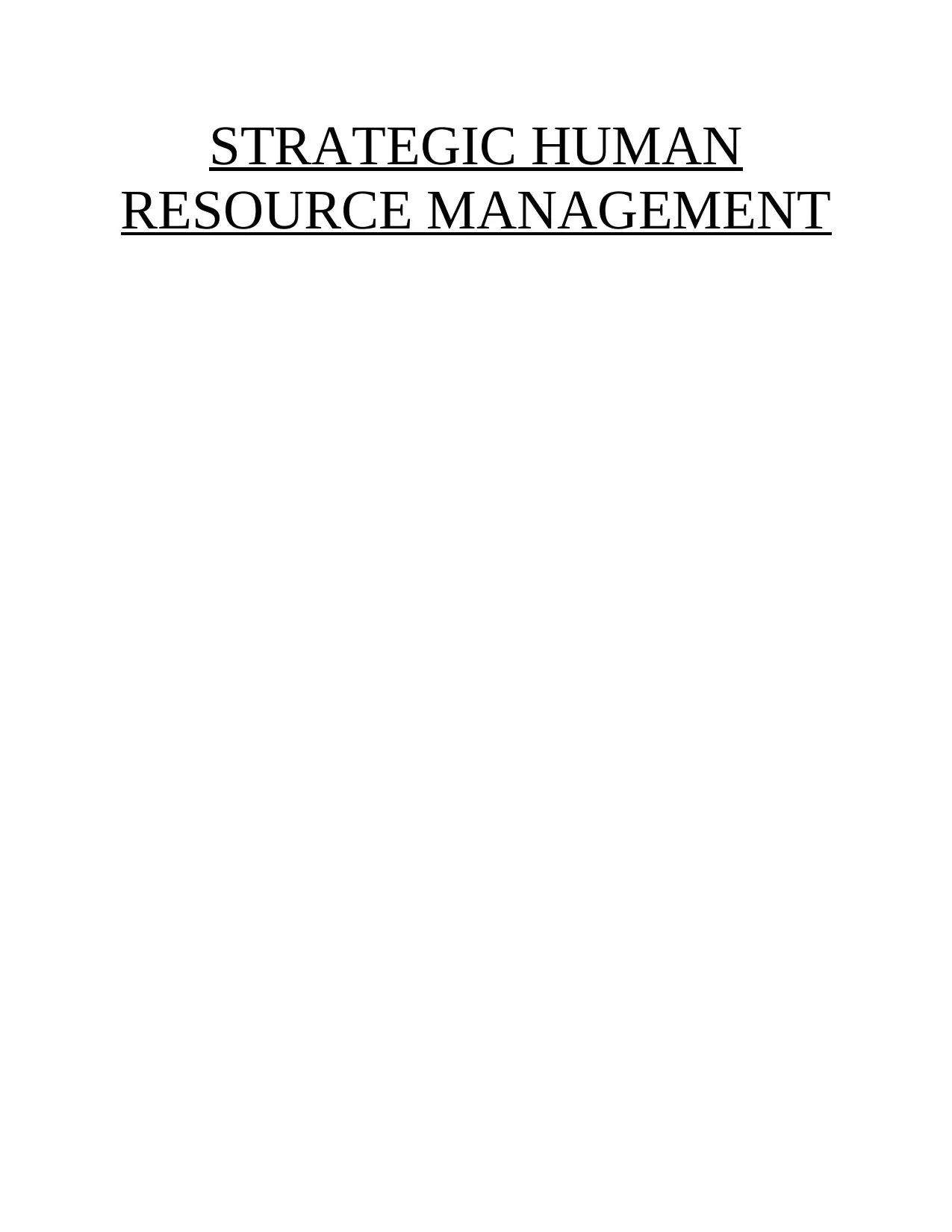
STRATEGIC HUMAN
RESOURCE MANAGEMENT
RESOURCE MANAGEMENT
Paraphrase This Document
Need a fresh take? Get an instant paraphrase of this document with our AI Paraphraser
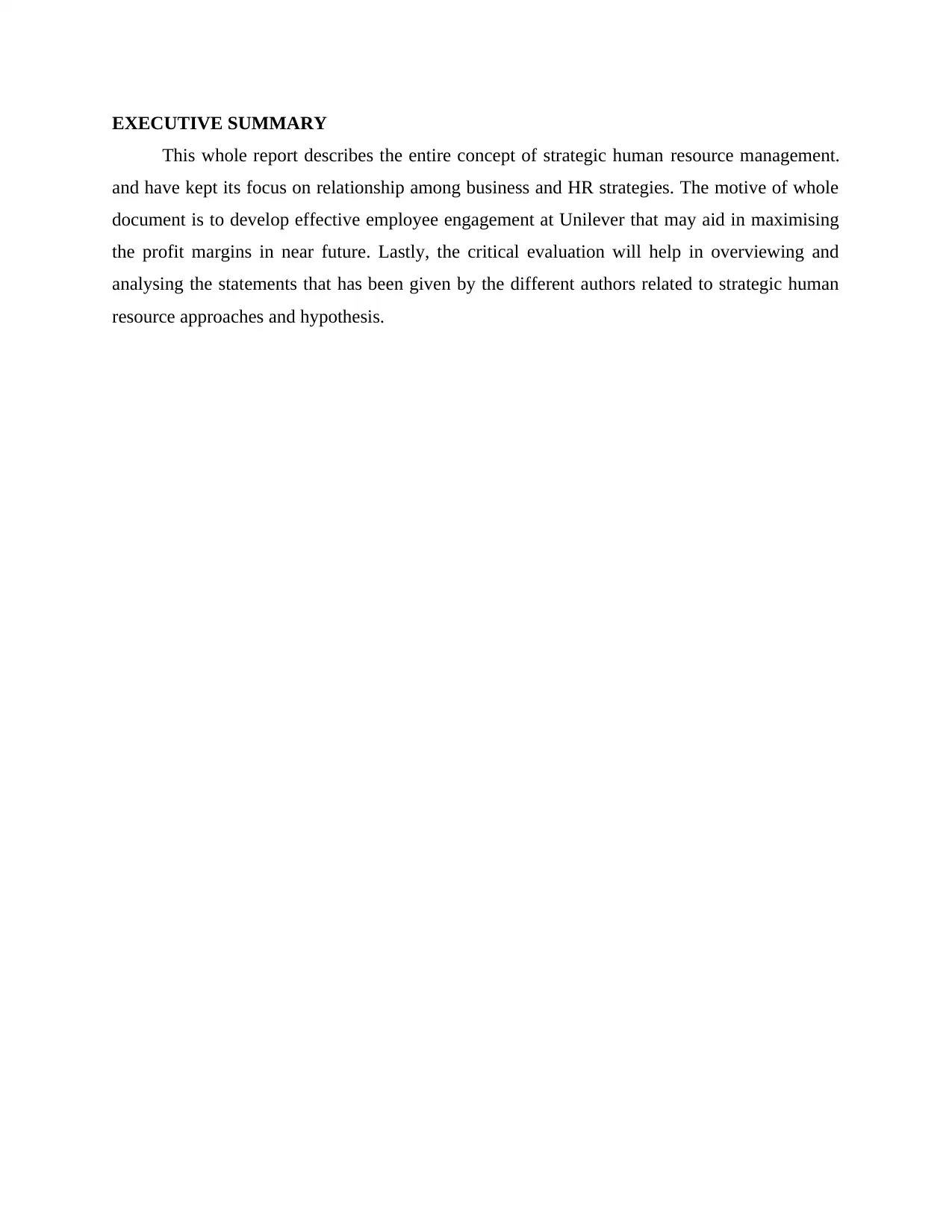
EXECUTIVE SUMMARY
This whole report describes the entire concept of strategic human resource management.
and have kept its focus on relationship among business and HR strategies. The motive of whole
document is to develop effective employee engagement at Unilever that may aid in maximising
the profit margins in near future. Lastly, the critical evaluation will help in overviewing and
analysing the statements that has been given by the different authors related to strategic human
resource approaches and hypothesis.
This whole report describes the entire concept of strategic human resource management.
and have kept its focus on relationship among business and HR strategies. The motive of whole
document is to develop effective employee engagement at Unilever that may aid in maximising
the profit margins in near future. Lastly, the critical evaluation will help in overviewing and
analysing the statements that has been given by the different authors related to strategic human
resource approaches and hypothesis.
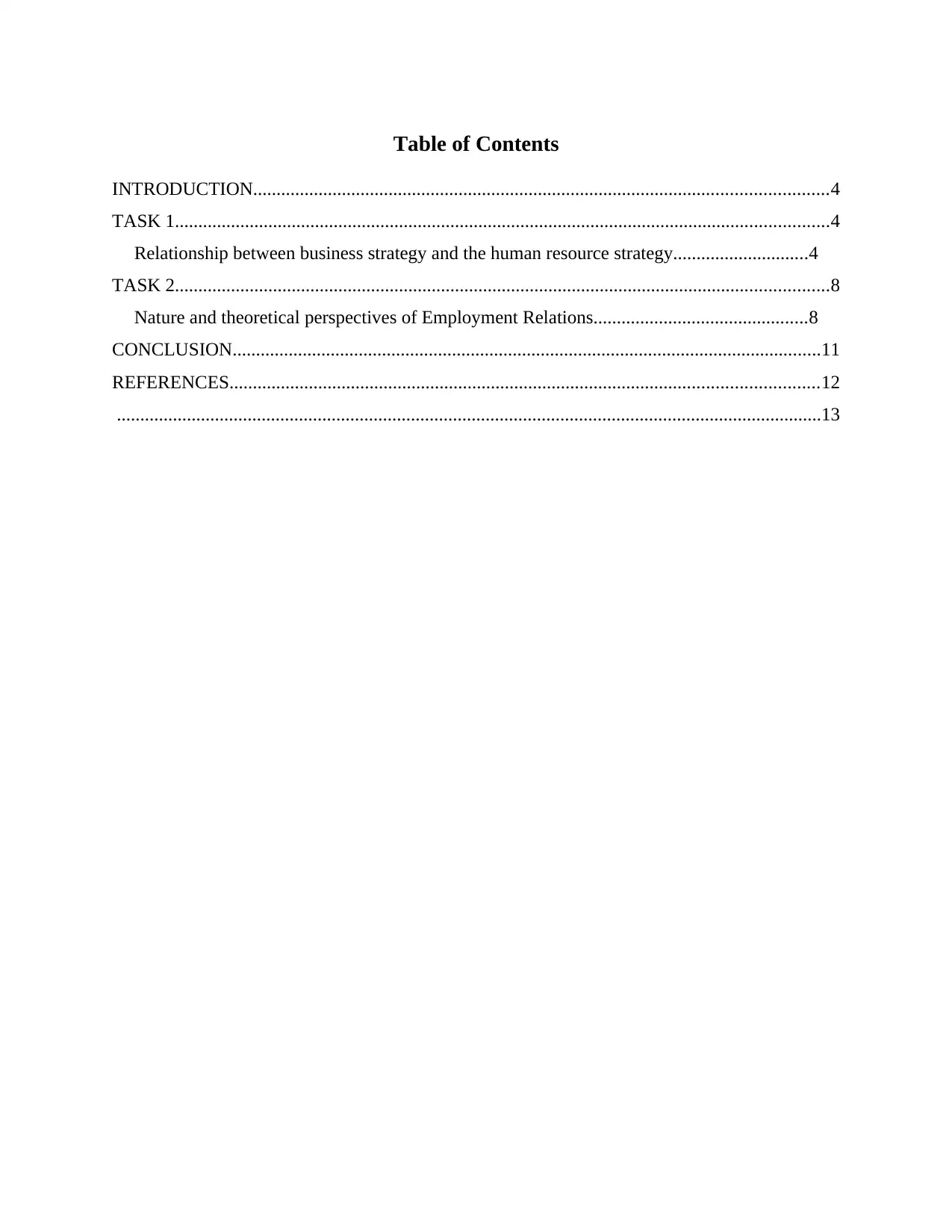
Table of Contents
INTRODUCTION...........................................................................................................................4
TASK 1............................................................................................................................................4
Relationship between business strategy and the human resource strategy.............................4
TASK 2............................................................................................................................................8
Nature and theoretical perspectives of Employment Relations..............................................8
CONCLUSION..............................................................................................................................11
REFERENCES..............................................................................................................................12
.......................................................................................................................................................13
INTRODUCTION...........................................................................................................................4
TASK 1............................................................................................................................................4
Relationship between business strategy and the human resource strategy.............................4
TASK 2............................................................................................................................................8
Nature and theoretical perspectives of Employment Relations..............................................8
CONCLUSION..............................................................................................................................11
REFERENCES..............................................................................................................................12
.......................................................................................................................................................13
⊘ This is a preview!⊘
Do you want full access?
Subscribe today to unlock all pages.

Trusted by 1+ million students worldwide
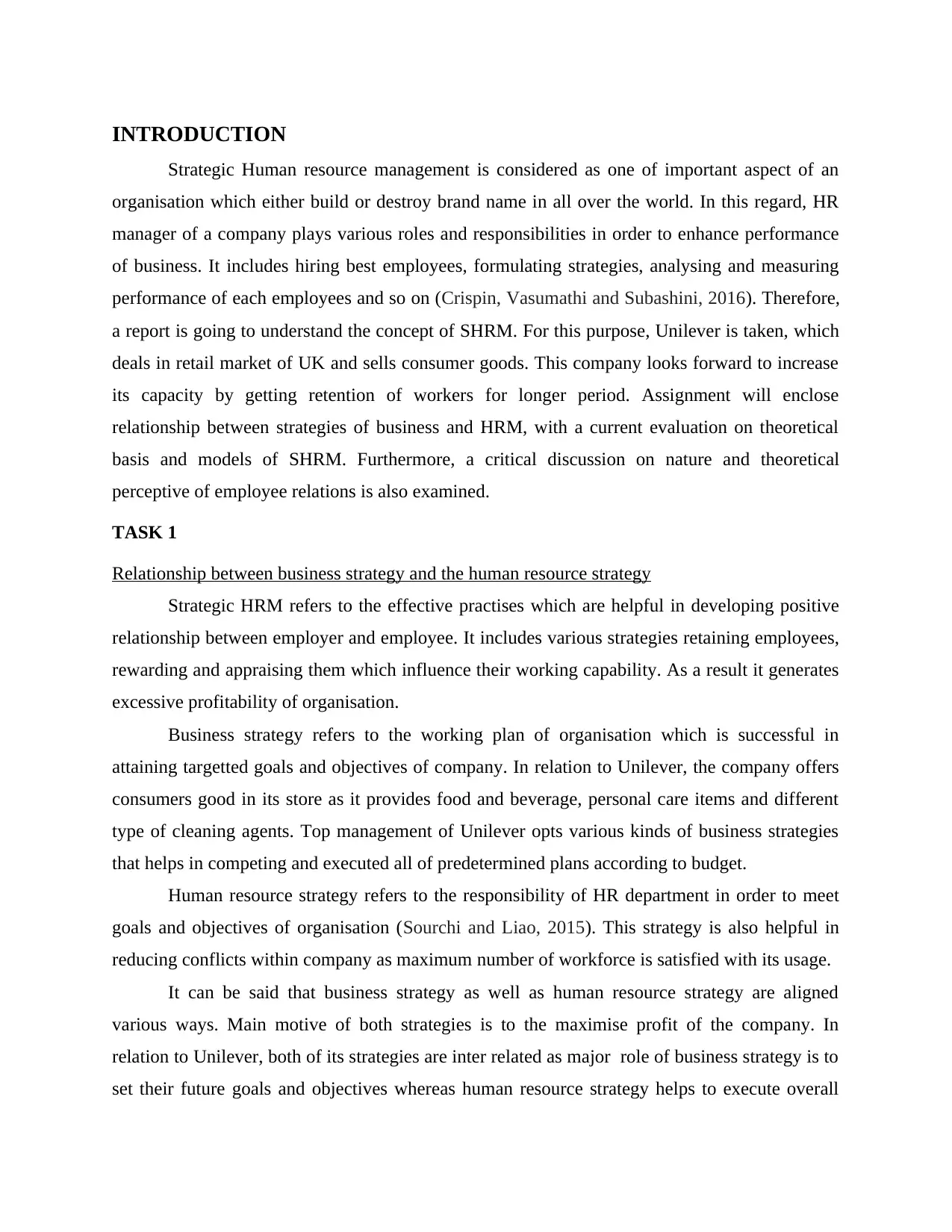
INTRODUCTION
Strategic Human resource management is considered as one of important aspect of an
organisation which either build or destroy brand name in all over the world. In this regard, HR
manager of a company plays various roles and responsibilities in order to enhance performance
of business. It includes hiring best employees, formulating strategies, analysing and measuring
performance of each employees and so on (Crispin, Vasumathi and Subashini, 2016). Therefore,
a report is going to understand the concept of SHRM. For this purpose, Unilever is taken, which
deals in retail market of UK and sells consumer goods. This company looks forward to increase
its capacity by getting retention of workers for longer period. Assignment will enclose
relationship between strategies of business and HRM, with a current evaluation on theoretical
basis and models of SHRM. Furthermore, a critical discussion on nature and theoretical
perceptive of employee relations is also examined.
TASK 1
Relationship between business strategy and the human resource strategy
Strategic HRM refers to the effective practises which are helpful in developing positive
relationship between employer and employee. It includes various strategies retaining employees,
rewarding and appraising them which influence their working capability. As a result it generates
excessive profitability of organisation.
Business strategy refers to the working plan of organisation which is successful in
attaining targetted goals and objectives of company. In relation to Unilever, the company offers
consumers good in its store as it provides food and beverage, personal care items and different
type of cleaning agents. Top management of Unilever opts various kinds of business strategies
that helps in competing and executed all of predetermined plans according to budget.
Human resource strategy refers to the responsibility of HR department in order to meet
goals and objectives of organisation (Sourchi and Liao, 2015). This strategy is also helpful in
reducing conflicts within company as maximum number of workforce is satisfied with its usage.
It can be said that business strategy as well as human resource strategy are aligned
various ways. Main motive of both strategies is to the maximise profit of the company. In
relation to Unilever, both of its strategies are inter related as major role of business strategy is to
set their future goals and objectives whereas human resource strategy helps to execute overall
Strategic Human resource management is considered as one of important aspect of an
organisation which either build or destroy brand name in all over the world. In this regard, HR
manager of a company plays various roles and responsibilities in order to enhance performance
of business. It includes hiring best employees, formulating strategies, analysing and measuring
performance of each employees and so on (Crispin, Vasumathi and Subashini, 2016). Therefore,
a report is going to understand the concept of SHRM. For this purpose, Unilever is taken, which
deals in retail market of UK and sells consumer goods. This company looks forward to increase
its capacity by getting retention of workers for longer period. Assignment will enclose
relationship between strategies of business and HRM, with a current evaluation on theoretical
basis and models of SHRM. Furthermore, a critical discussion on nature and theoretical
perceptive of employee relations is also examined.
TASK 1
Relationship between business strategy and the human resource strategy
Strategic HRM refers to the effective practises which are helpful in developing positive
relationship between employer and employee. It includes various strategies retaining employees,
rewarding and appraising them which influence their working capability. As a result it generates
excessive profitability of organisation.
Business strategy refers to the working plan of organisation which is successful in
attaining targetted goals and objectives of company. In relation to Unilever, the company offers
consumers good in its store as it provides food and beverage, personal care items and different
type of cleaning agents. Top management of Unilever opts various kinds of business strategies
that helps in competing and executed all of predetermined plans according to budget.
Human resource strategy refers to the responsibility of HR department in order to meet
goals and objectives of organisation (Sourchi and Liao, 2015). This strategy is also helpful in
reducing conflicts within company as maximum number of workforce is satisfied with its usage.
It can be said that business strategy as well as human resource strategy are aligned
various ways. Main motive of both strategies is to the maximise profit of the company. In
relation to Unilever, both of its strategies are inter related as major role of business strategy is to
set their future goals and objectives whereas human resource strategy helps to execute overall
Paraphrase This Document
Need a fresh take? Get an instant paraphrase of this document with our AI Paraphraser
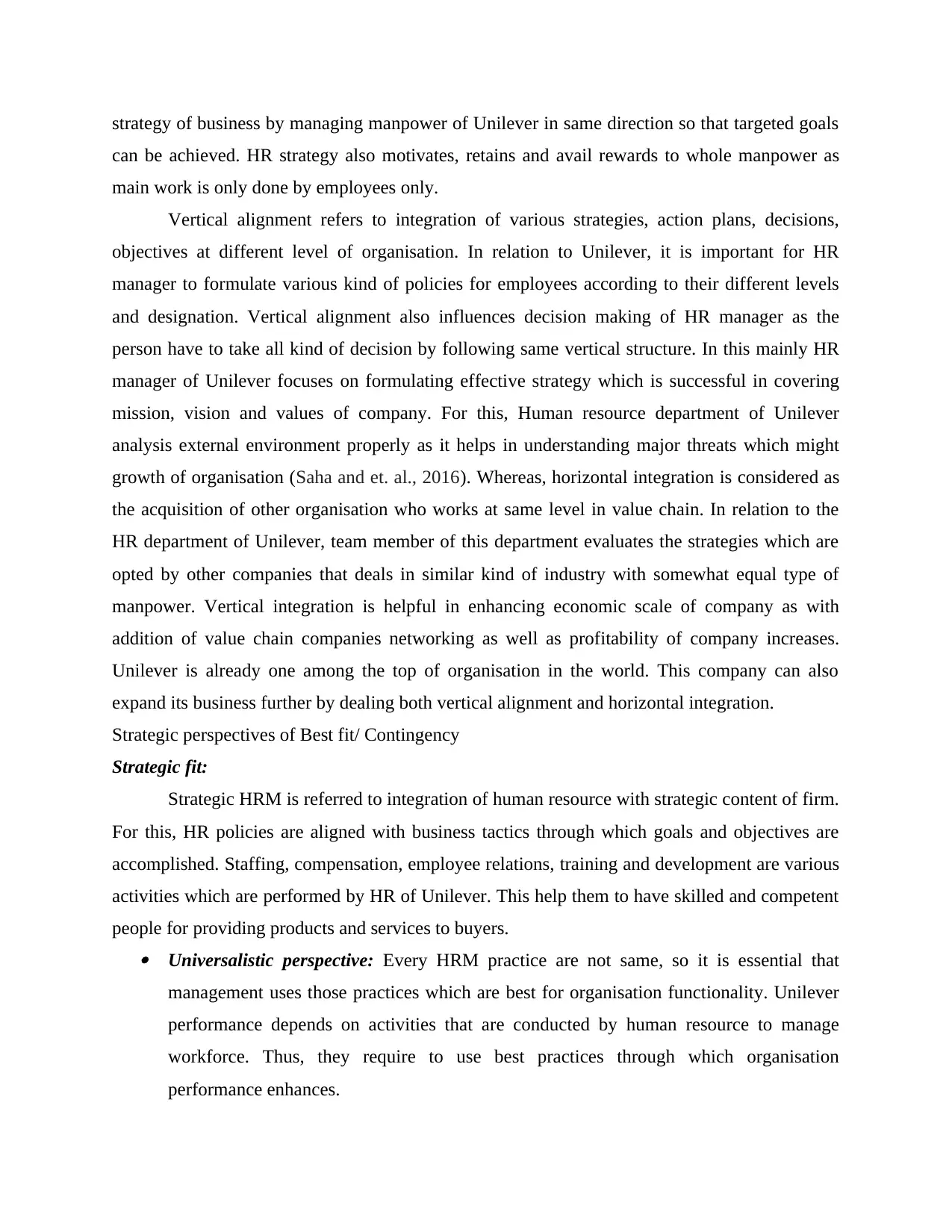
strategy of business by managing manpower of Unilever in same direction so that targeted goals
can be achieved. HR strategy also motivates, retains and avail rewards to whole manpower as
main work is only done by employees only.
Vertical alignment refers to integration of various strategies, action plans, decisions,
objectives at different level of organisation. In relation to Unilever, it is important for HR
manager to formulate various kind of policies for employees according to their different levels
and designation. Vertical alignment also influences decision making of HR manager as the
person have to take all kind of decision by following same vertical structure. In this mainly HR
manager of Unilever focuses on formulating effective strategy which is successful in covering
mission, vision and values of company. For this, Human resource department of Unilever
analysis external environment properly as it helps in understanding major threats which might
growth of organisation (Saha and et. al., 2016). Whereas, horizontal integration is considered as
the acquisition of other organisation who works at same level in value chain. In relation to the
HR department of Unilever, team member of this department evaluates the strategies which are
opted by other companies that deals in similar kind of industry with somewhat equal type of
manpower. Vertical integration is helpful in enhancing economic scale of company as with
addition of value chain companies networking as well as profitability of company increases.
Unilever is already one among the top of organisation in the world. This company can also
expand its business further by dealing both vertical alignment and horizontal integration.
Strategic perspectives of Best fit/ Contingency
Strategic fit:
Strategic HRM is referred to integration of human resource with strategic content of firm.
For this, HR policies are aligned with business tactics through which goals and objectives are
accomplished. Staffing, compensation, employee relations, training and development are various
activities which are performed by HR of Unilever. This help them to have skilled and competent
people for providing products and services to buyers. Universalistic perspective: Every HRM practice are not same, so it is essential that
management uses those practices which are best for organisation functionality. Unilever
performance depends on activities that are conducted by human resource to manage
workforce. Thus, they require to use best practices through which organisation
performance enhances.
can be achieved. HR strategy also motivates, retains and avail rewards to whole manpower as
main work is only done by employees only.
Vertical alignment refers to integration of various strategies, action plans, decisions,
objectives at different level of organisation. In relation to Unilever, it is important for HR
manager to formulate various kind of policies for employees according to their different levels
and designation. Vertical alignment also influences decision making of HR manager as the
person have to take all kind of decision by following same vertical structure. In this mainly HR
manager of Unilever focuses on formulating effective strategy which is successful in covering
mission, vision and values of company. For this, Human resource department of Unilever
analysis external environment properly as it helps in understanding major threats which might
growth of organisation (Saha and et. al., 2016). Whereas, horizontal integration is considered as
the acquisition of other organisation who works at same level in value chain. In relation to the
HR department of Unilever, team member of this department evaluates the strategies which are
opted by other companies that deals in similar kind of industry with somewhat equal type of
manpower. Vertical integration is helpful in enhancing economic scale of company as with
addition of value chain companies networking as well as profitability of company increases.
Unilever is already one among the top of organisation in the world. This company can also
expand its business further by dealing both vertical alignment and horizontal integration.
Strategic perspectives of Best fit/ Contingency
Strategic fit:
Strategic HRM is referred to integration of human resource with strategic content of firm.
For this, HR policies are aligned with business tactics through which goals and objectives are
accomplished. Staffing, compensation, employee relations, training and development are various
activities which are performed by HR of Unilever. This help them to have skilled and competent
people for providing products and services to buyers. Universalistic perspective: Every HRM practice are not same, so it is essential that
management uses those practices which are best for organisation functionality. Unilever
performance depends on activities that are conducted by human resource to manage
workforce. Thus, they require to use best practices through which organisation
performance enhances.
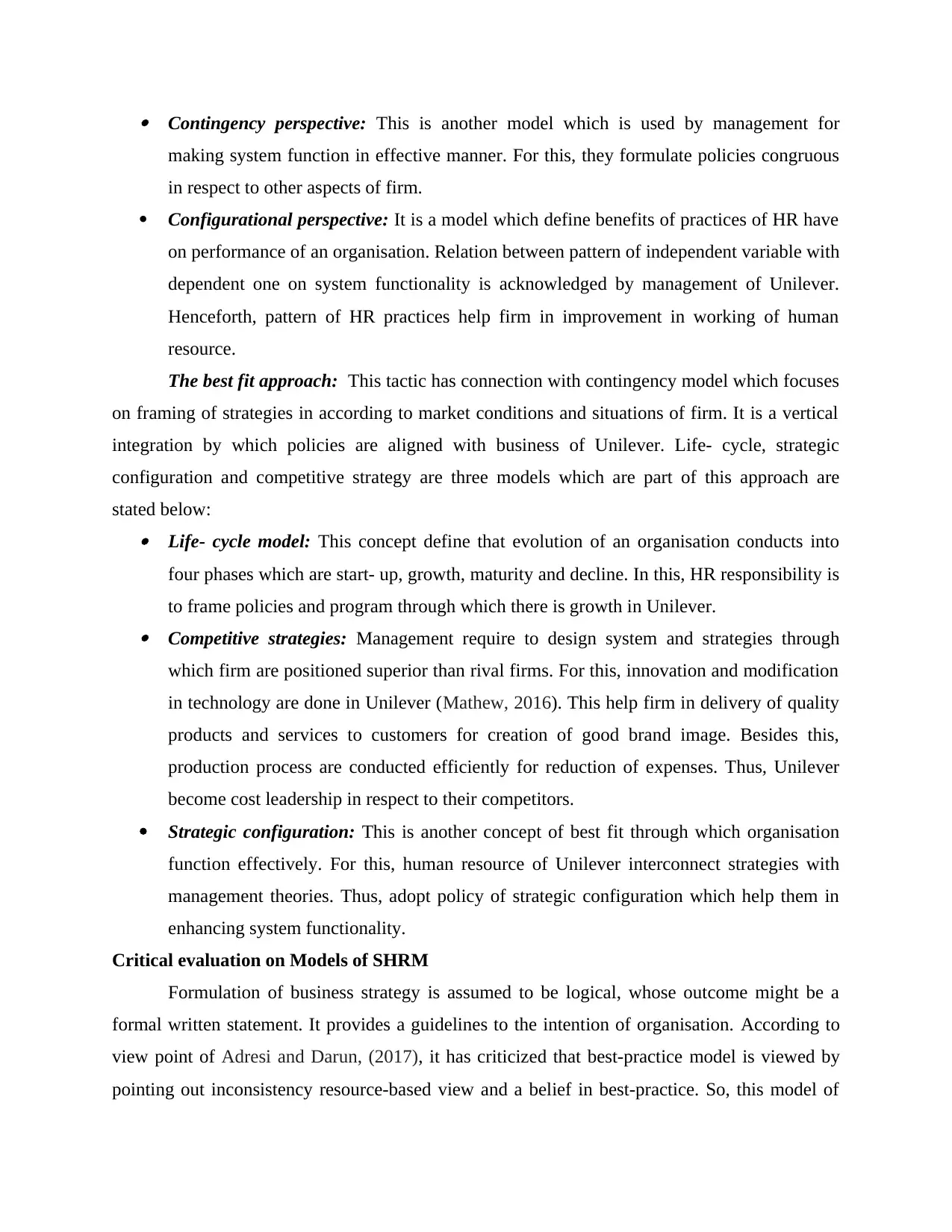
Contingency perspective: This is another model which is used by management for
making system function in effective manner. For this, they formulate policies congruous
in respect to other aspects of firm.
Configurational perspective: It is a model which define benefits of practices of HR have
on performance of an organisation. Relation between pattern of independent variable with
dependent one on system functionality is acknowledged by management of Unilever.
Henceforth, pattern of HR practices help firm in improvement in working of human
resource.
The best fit approach: This tactic has connection with contingency model which focuses
on framing of strategies in according to market conditions and situations of firm. It is a vertical
integration by which policies are aligned with business of Unilever. Life- cycle, strategic
configuration and competitive strategy are three models which are part of this approach are
stated below: Life- cycle model: This concept define that evolution of an organisation conducts into
four phases which are start- up, growth, maturity and decline. In this, HR responsibility is
to frame policies and program through which there is growth in Unilever. Competitive strategies: Management require to design system and strategies through
which firm are positioned superior than rival firms. For this, innovation and modification
in technology are done in Unilever (Mathew, 2016). This help firm in delivery of quality
products and services to customers for creation of good brand image. Besides this,
production process are conducted efficiently for reduction of expenses. Thus, Unilever
become cost leadership in respect to their competitors.
Strategic configuration: This is another concept of best fit through which organisation
function effectively. For this, human resource of Unilever interconnect strategies with
management theories. Thus, adopt policy of strategic configuration which help them in
enhancing system functionality.
Critical evaluation on Models of SHRM
Formulation of business strategy is assumed to be logical, whose outcome might be a
formal written statement. It provides a guidelines to the intention of organisation. According to
view point of Adresi and Darun, (2017), it has criticized that best-practice model is viewed by
pointing out inconsistency resource-based view and a belief in best-practice. So, this model of
making system function in effective manner. For this, they formulate policies congruous
in respect to other aspects of firm.
Configurational perspective: It is a model which define benefits of practices of HR have
on performance of an organisation. Relation between pattern of independent variable with
dependent one on system functionality is acknowledged by management of Unilever.
Henceforth, pattern of HR practices help firm in improvement in working of human
resource.
The best fit approach: This tactic has connection with contingency model which focuses
on framing of strategies in according to market conditions and situations of firm. It is a vertical
integration by which policies are aligned with business of Unilever. Life- cycle, strategic
configuration and competitive strategy are three models which are part of this approach are
stated below: Life- cycle model: This concept define that evolution of an organisation conducts into
four phases which are start- up, growth, maturity and decline. In this, HR responsibility is
to frame policies and program through which there is growth in Unilever. Competitive strategies: Management require to design system and strategies through
which firm are positioned superior than rival firms. For this, innovation and modification
in technology are done in Unilever (Mathew, 2016). This help firm in delivery of quality
products and services to customers for creation of good brand image. Besides this,
production process are conducted efficiently for reduction of expenses. Thus, Unilever
become cost leadership in respect to their competitors.
Strategic configuration: This is another concept of best fit through which organisation
function effectively. For this, human resource of Unilever interconnect strategies with
management theories. Thus, adopt policy of strategic configuration which help them in
enhancing system functionality.
Critical evaluation on Models of SHRM
Formulation of business strategy is assumed to be logical, whose outcome might be a
formal written statement. It provides a guidelines to the intention of organisation. According to
view point of Adresi and Darun, (2017), it has criticized that best-practice model is viewed by
pointing out inconsistency resource-based view and a belief in best-practice. So, this model of
⊘ This is a preview!⊘
Do you want full access?
Subscribe today to unlock all pages.

Trusted by 1+ million students worldwide
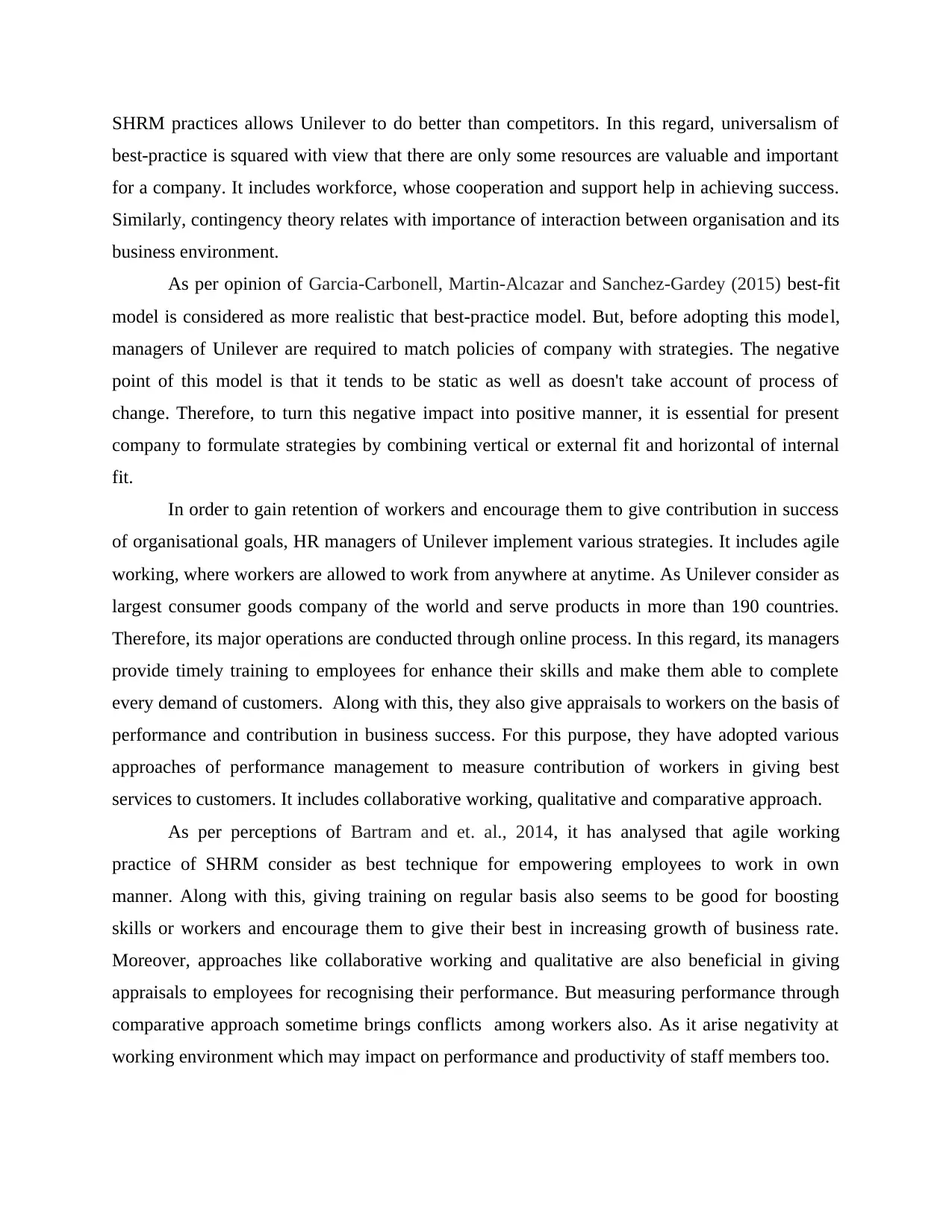
SHRM practices allows Unilever to do better than competitors. In this regard, universalism of
best-practice is squared with view that there are only some resources are valuable and important
for a company. It includes workforce, whose cooperation and support help in achieving success.
Similarly, contingency theory relates with importance of interaction between organisation and its
business environment.
As per opinion of Garcia-Carbonell, Martin-Alcazar and Sanchez-Gardey (2015) best-fit
model is considered as more realistic that best-practice model. But, before adopting this model,
managers of Unilever are required to match policies of company with strategies. The negative
point of this model is that it tends to be static as well as doesn't take account of process of
change. Therefore, to turn this negative impact into positive manner, it is essential for present
company to formulate strategies by combining vertical or external fit and horizontal of internal
fit.
In order to gain retention of workers and encourage them to give contribution in success
of organisational goals, HR managers of Unilever implement various strategies. It includes agile
working, where workers are allowed to work from anywhere at anytime. As Unilever consider as
largest consumer goods company of the world and serve products in more than 190 countries.
Therefore, its major operations are conducted through online process. In this regard, its managers
provide timely training to employees for enhance their skills and make them able to complete
every demand of customers. Along with this, they also give appraisals to workers on the basis of
performance and contribution in business success. For this purpose, they have adopted various
approaches of performance management to measure contribution of workers in giving best
services to customers. It includes collaborative working, qualitative and comparative approach.
As per perceptions of Bartram and et. al., 2014, it has analysed that agile working
practice of SHRM consider as best technique for empowering employees to work in own
manner. Along with this, giving training on regular basis also seems to be good for boosting
skills or workers and encourage them to give their best in increasing growth of business rate.
Moreover, approaches like collaborative working and qualitative are also beneficial in giving
appraisals to employees for recognising their performance. But measuring performance through
comparative approach sometime brings conflicts among workers also. As it arise negativity at
working environment which may impact on performance and productivity of staff members too.
best-practice is squared with view that there are only some resources are valuable and important
for a company. It includes workforce, whose cooperation and support help in achieving success.
Similarly, contingency theory relates with importance of interaction between organisation and its
business environment.
As per opinion of Garcia-Carbonell, Martin-Alcazar and Sanchez-Gardey (2015) best-fit
model is considered as more realistic that best-practice model. But, before adopting this model,
managers of Unilever are required to match policies of company with strategies. The negative
point of this model is that it tends to be static as well as doesn't take account of process of
change. Therefore, to turn this negative impact into positive manner, it is essential for present
company to formulate strategies by combining vertical or external fit and horizontal of internal
fit.
In order to gain retention of workers and encourage them to give contribution in success
of organisational goals, HR managers of Unilever implement various strategies. It includes agile
working, where workers are allowed to work from anywhere at anytime. As Unilever consider as
largest consumer goods company of the world and serve products in more than 190 countries.
Therefore, its major operations are conducted through online process. In this regard, its managers
provide timely training to employees for enhance their skills and make them able to complete
every demand of customers. Along with this, they also give appraisals to workers on the basis of
performance and contribution in business success. For this purpose, they have adopted various
approaches of performance management to measure contribution of workers in giving best
services to customers. It includes collaborative working, qualitative and comparative approach.
As per perceptions of Bartram and et. al., 2014, it has analysed that agile working
practice of SHRM consider as best technique for empowering employees to work in own
manner. Along with this, giving training on regular basis also seems to be good for boosting
skills or workers and encourage them to give their best in increasing growth of business rate.
Moreover, approaches like collaborative working and qualitative are also beneficial in giving
appraisals to employees for recognising their performance. But measuring performance through
comparative approach sometime brings conflicts among workers also. As it arise negativity at
working environment which may impact on performance and productivity of staff members too.
Paraphrase This Document
Need a fresh take? Get an instant paraphrase of this document with our AI Paraphraser
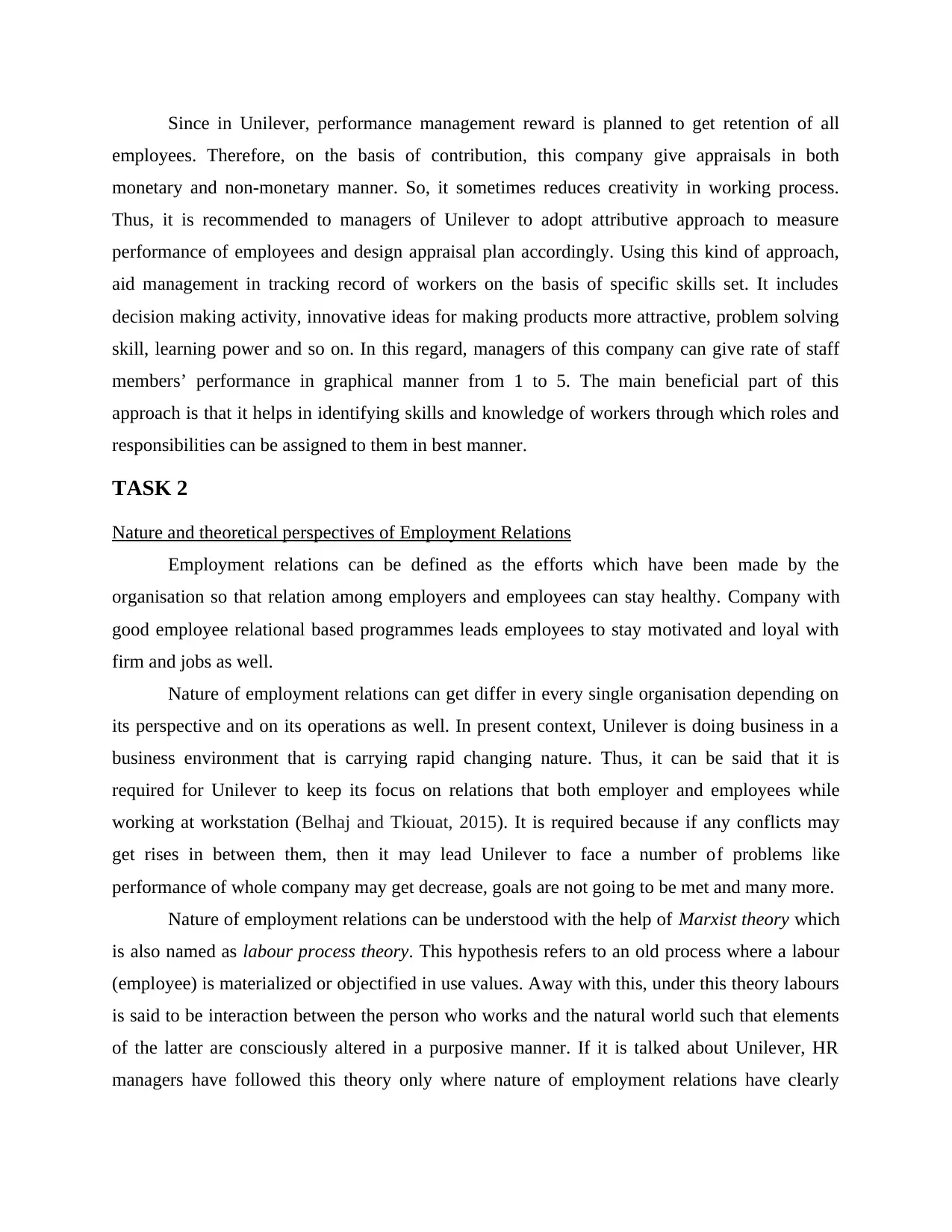
Since in Unilever, performance management reward is planned to get retention of all
employees. Therefore, on the basis of contribution, this company give appraisals in both
monetary and non-monetary manner. So, it sometimes reduces creativity in working process.
Thus, it is recommended to managers of Unilever to adopt attributive approach to measure
performance of employees and design appraisal plan accordingly. Using this kind of approach,
aid management in tracking record of workers on the basis of specific skills set. It includes
decision making activity, innovative ideas for making products more attractive, problem solving
skill, learning power and so on. In this regard, managers of this company can give rate of staff
members’ performance in graphical manner from 1 to 5. The main beneficial part of this
approach is that it helps in identifying skills and knowledge of workers through which roles and
responsibilities can be assigned to them in best manner.
TASK 2
Nature and theoretical perspectives of Employment Relations
Employment relations can be defined as the efforts which have been made by the
organisation so that relation among employers and employees can stay healthy. Company with
good employee relational based programmes leads employees to stay motivated and loyal with
firm and jobs as well.
Nature of employment relations can get differ in every single organisation depending on
its perspective and on its operations as well. In present context, Unilever is doing business in a
business environment that is carrying rapid changing nature. Thus, it can be said that it is
required for Unilever to keep its focus on relations that both employer and employees while
working at workstation (Belhaj and Tkiouat, 2015). It is required because if any conflicts may
get rises in between them, then it may lead Unilever to face a number of problems like
performance of whole company may get decrease, goals are not going to be met and many more.
Nature of employment relations can be understood with the help of Marxist theory which
is also named as labour process theory. This hypothesis refers to an old process where a labour
(employee) is materialized or objectified in use values. Away with this, under this theory labours
is said to be interaction between the person who works and the natural world such that elements
of the latter are consciously altered in a purposive manner. If it is talked about Unilever, HR
managers have followed this theory only where nature of employment relations have clearly
employees. Therefore, on the basis of contribution, this company give appraisals in both
monetary and non-monetary manner. So, it sometimes reduces creativity in working process.
Thus, it is recommended to managers of Unilever to adopt attributive approach to measure
performance of employees and design appraisal plan accordingly. Using this kind of approach,
aid management in tracking record of workers on the basis of specific skills set. It includes
decision making activity, innovative ideas for making products more attractive, problem solving
skill, learning power and so on. In this regard, managers of this company can give rate of staff
members’ performance in graphical manner from 1 to 5. The main beneficial part of this
approach is that it helps in identifying skills and knowledge of workers through which roles and
responsibilities can be assigned to them in best manner.
TASK 2
Nature and theoretical perspectives of Employment Relations
Employment relations can be defined as the efforts which have been made by the
organisation so that relation among employers and employees can stay healthy. Company with
good employee relational based programmes leads employees to stay motivated and loyal with
firm and jobs as well.
Nature of employment relations can get differ in every single organisation depending on
its perspective and on its operations as well. In present context, Unilever is doing business in a
business environment that is carrying rapid changing nature. Thus, it can be said that it is
required for Unilever to keep its focus on relations that both employer and employees while
working at workstation (Belhaj and Tkiouat, 2015). It is required because if any conflicts may
get rises in between them, then it may lead Unilever to face a number of problems like
performance of whole company may get decrease, goals are not going to be met and many more.
Nature of employment relations can be understood with the help of Marxist theory which
is also named as labour process theory. This hypothesis refers to an old process where a labour
(employee) is materialized or objectified in use values. Away with this, under this theory labours
is said to be interaction between the person who works and the natural world such that elements
of the latter are consciously altered in a purposive manner. If it is talked about Unilever, HR
managers have followed this theory only where nature of employment relations have clearly
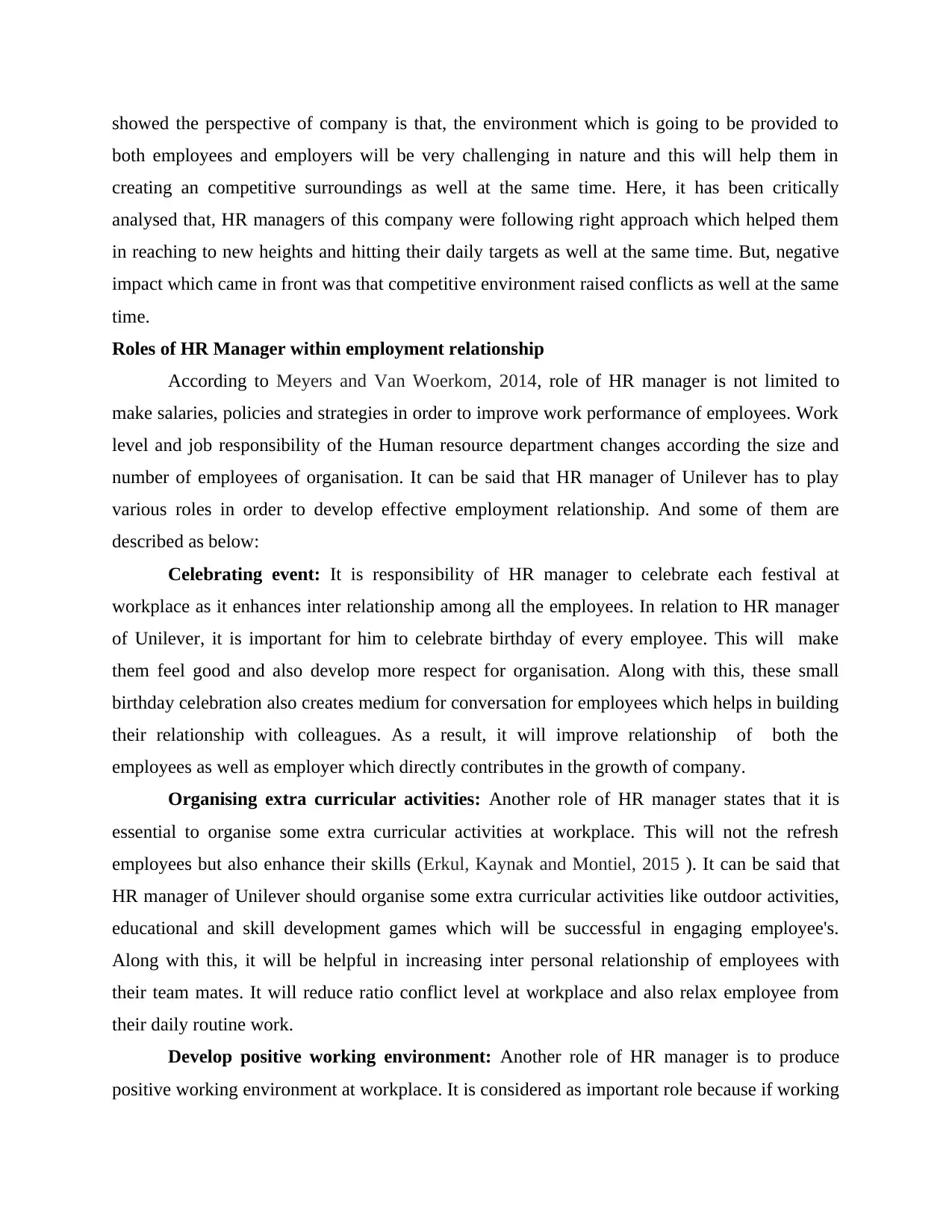
showed the perspective of company is that, the environment which is going to be provided to
both employees and employers will be very challenging in nature and this will help them in
creating an competitive surroundings as well at the same time. Here, it has been critically
analysed that, HR managers of this company were following right approach which helped them
in reaching to new heights and hitting their daily targets as well at the same time. But, negative
impact which came in front was that competitive environment raised conflicts as well at the same
time.
Roles of HR Manager within employment relationship
According to Meyers and Van Woerkom, 2014, role of HR manager is not limited to
make salaries, policies and strategies in order to improve work performance of employees. Work
level and job responsibility of the Human resource department changes according the size and
number of employees of organisation. It can be said that HR manager of Unilever has to play
various roles in order to develop effective employment relationship. And some of them are
described as below:
Celebrating event: It is responsibility of HR manager to celebrate each festival at
workplace as it enhances inter relationship among all the employees. In relation to HR manager
of Unilever, it is important for him to celebrate birthday of every employee. This will make
them feel good and also develop more respect for organisation. Along with this, these small
birthday celebration also creates medium for conversation for employees which helps in building
their relationship with colleagues. As a result, it will improve relationship of both the
employees as well as employer which directly contributes in the growth of company.
Organising extra curricular activities: Another role of HR manager states that it is
essential to organise some extra curricular activities at workplace. This will not the refresh
employees but also enhance their skills (Erkul, Kaynak and Montiel, 2015 ). It can be said that
HR manager of Unilever should organise some extra curricular activities like outdoor activities,
educational and skill development games which will be successful in engaging employee's.
Along with this, it will be helpful in increasing inter personal relationship of employees with
their team mates. It will reduce ratio conflict level at workplace and also relax employee from
their daily routine work.
Develop positive working environment: Another role of HR manager is to produce
positive working environment at workplace. It is considered as important role because if working
both employees and employers will be very challenging in nature and this will help them in
creating an competitive surroundings as well at the same time. Here, it has been critically
analysed that, HR managers of this company were following right approach which helped them
in reaching to new heights and hitting their daily targets as well at the same time. But, negative
impact which came in front was that competitive environment raised conflicts as well at the same
time.
Roles of HR Manager within employment relationship
According to Meyers and Van Woerkom, 2014, role of HR manager is not limited to
make salaries, policies and strategies in order to improve work performance of employees. Work
level and job responsibility of the Human resource department changes according the size and
number of employees of organisation. It can be said that HR manager of Unilever has to play
various roles in order to develop effective employment relationship. And some of them are
described as below:
Celebrating event: It is responsibility of HR manager to celebrate each festival at
workplace as it enhances inter relationship among all the employees. In relation to HR manager
of Unilever, it is important for him to celebrate birthday of every employee. This will make
them feel good and also develop more respect for organisation. Along with this, these small
birthday celebration also creates medium for conversation for employees which helps in building
their relationship with colleagues. As a result, it will improve relationship of both the
employees as well as employer which directly contributes in the growth of company.
Organising extra curricular activities: Another role of HR manager states that it is
essential to organise some extra curricular activities at workplace. This will not the refresh
employees but also enhance their skills (Erkul, Kaynak and Montiel, 2015 ). It can be said that
HR manager of Unilever should organise some extra curricular activities like outdoor activities,
educational and skill development games which will be successful in engaging employee's.
Along with this, it will be helpful in increasing inter personal relationship of employees with
their team mates. It will reduce ratio conflict level at workplace and also relax employee from
their daily routine work.
Develop positive working environment: Another role of HR manager is to produce
positive working environment at workplace. It is considered as important role because if working
⊘ This is a preview!⊘
Do you want full access?
Subscribe today to unlock all pages.

Trusted by 1+ million students worldwide
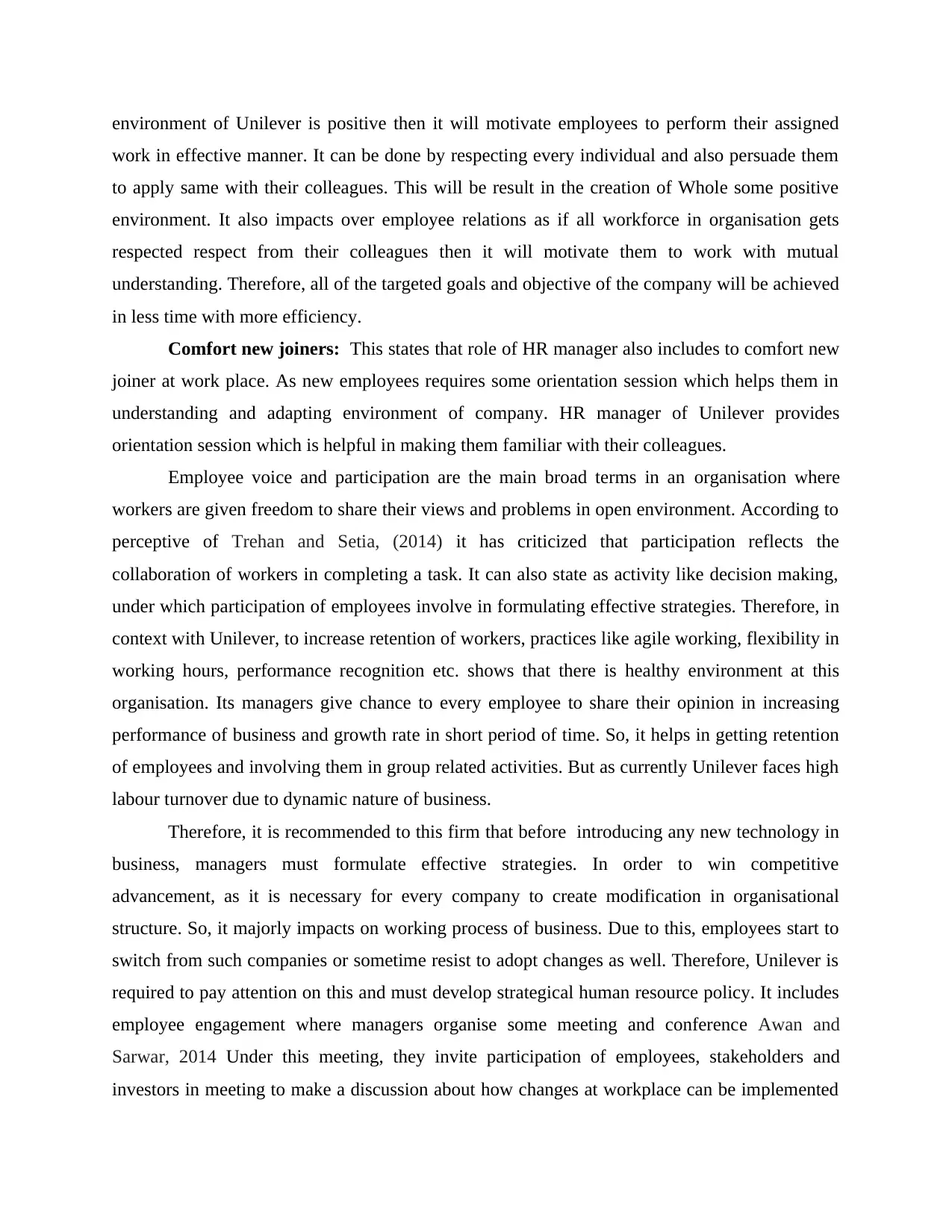
environment of Unilever is positive then it will motivate employees to perform their assigned
work in effective manner. It can be done by respecting every individual and also persuade them
to apply same with their colleagues. This will be result in the creation of Whole some positive
environment. It also impacts over employee relations as if all workforce in organisation gets
respected respect from their colleagues then it will motivate them to work with mutual
understanding. Therefore, all of the targeted goals and objective of the company will be achieved
in less time with more efficiency.
Comfort new joiners: This states that role of HR manager also includes to comfort new
joiner at work place. As new employees requires some orientation session which helps them in
understanding and adapting environment of company. HR manager of Unilever provides
orientation session which is helpful in making them familiar with their colleagues.
Employee voice and participation are the main broad terms in an organisation where
workers are given freedom to share their views and problems in open environment. According to
perceptive of Trehan and Setia, (2014) it has criticized that participation reflects the
collaboration of workers in completing a task. It can also state as activity like decision making,
under which participation of employees involve in formulating effective strategies. Therefore, in
context with Unilever, to increase retention of workers, practices like agile working, flexibility in
working hours, performance recognition etc. shows that there is healthy environment at this
organisation. Its managers give chance to every employee to share their opinion in increasing
performance of business and growth rate in short period of time. So, it helps in getting retention
of employees and involving them in group related activities. But as currently Unilever faces high
labour turnover due to dynamic nature of business.
Therefore, it is recommended to this firm that before introducing any new technology in
business, managers must formulate effective strategies. In order to win competitive
advancement, as it is necessary for every company to create modification in organisational
structure. So, it majorly impacts on working process of business. Due to this, employees start to
switch from such companies or sometime resist to adopt changes as well. Therefore, Unilever is
required to pay attention on this and must develop strategical human resource policy. It includes
employee engagement where managers organise some meeting and conference Awan and
Sarwar, 2014 Under this meeting, they invite participation of employees, stakeholders and
investors in meeting to make a discussion about how changes at workplace can be implemented
work in effective manner. It can be done by respecting every individual and also persuade them
to apply same with their colleagues. This will be result in the creation of Whole some positive
environment. It also impacts over employee relations as if all workforce in organisation gets
respected respect from their colleagues then it will motivate them to work with mutual
understanding. Therefore, all of the targeted goals and objective of the company will be achieved
in less time with more efficiency.
Comfort new joiners: This states that role of HR manager also includes to comfort new
joiner at work place. As new employees requires some orientation session which helps them in
understanding and adapting environment of company. HR manager of Unilever provides
orientation session which is helpful in making them familiar with their colleagues.
Employee voice and participation are the main broad terms in an organisation where
workers are given freedom to share their views and problems in open environment. According to
perceptive of Trehan and Setia, (2014) it has criticized that participation reflects the
collaboration of workers in completing a task. It can also state as activity like decision making,
under which participation of employees involve in formulating effective strategies. Therefore, in
context with Unilever, to increase retention of workers, practices like agile working, flexibility in
working hours, performance recognition etc. shows that there is healthy environment at this
organisation. Its managers give chance to every employee to share their opinion in increasing
performance of business and growth rate in short period of time. So, it helps in getting retention
of employees and involving them in group related activities. But as currently Unilever faces high
labour turnover due to dynamic nature of business.
Therefore, it is recommended to this firm that before introducing any new technology in
business, managers must formulate effective strategies. In order to win competitive
advancement, as it is necessary for every company to create modification in organisational
structure. So, it majorly impacts on working process of business. Due to this, employees start to
switch from such companies or sometime resist to adopt changes as well. Therefore, Unilever is
required to pay attention on this and must develop strategical human resource policy. It includes
employee engagement where managers organise some meeting and conference Awan and
Sarwar, 2014 Under this meeting, they invite participation of employees, stakeholders and
investors in meeting to make a discussion about how changes at workplace can be implemented
Paraphrase This Document
Need a fresh take? Get an instant paraphrase of this document with our AI Paraphraser
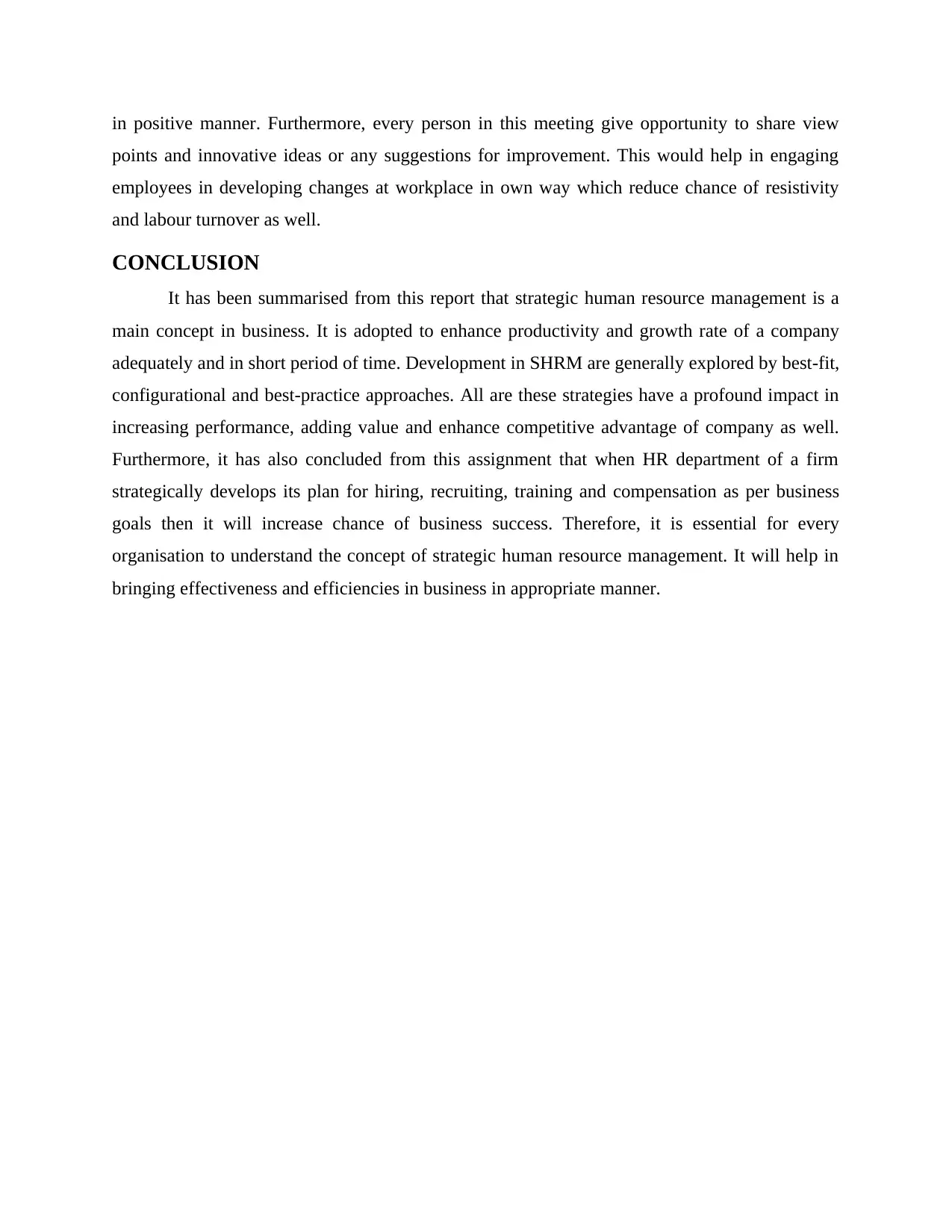
in positive manner. Furthermore, every person in this meeting give opportunity to share view
points and innovative ideas or any suggestions for improvement. This would help in engaging
employees in developing changes at workplace in own way which reduce chance of resistivity
and labour turnover as well.
CONCLUSION
It has been summarised from this report that strategic human resource management is a
main concept in business. It is adopted to enhance productivity and growth rate of a company
adequately and in short period of time. Development in SHRM are generally explored by best-fit,
configurational and best-practice approaches. All are these strategies have a profound impact in
increasing performance, adding value and enhance competitive advantage of company as well.
Furthermore, it has also concluded from this assignment that when HR department of a firm
strategically develops its plan for hiring, recruiting, training and compensation as per business
goals then it will increase chance of business success. Therefore, it is essential for every
organisation to understand the concept of strategic human resource management. It will help in
bringing effectiveness and efficiencies in business in appropriate manner.
points and innovative ideas or any suggestions for improvement. This would help in engaging
employees in developing changes at workplace in own way which reduce chance of resistivity
and labour turnover as well.
CONCLUSION
It has been summarised from this report that strategic human resource management is a
main concept in business. It is adopted to enhance productivity and growth rate of a company
adequately and in short period of time. Development in SHRM are generally explored by best-fit,
configurational and best-practice approaches. All are these strategies have a profound impact in
increasing performance, adding value and enhance competitive advantage of company as well.
Furthermore, it has also concluded from this assignment that when HR department of a firm
strategically develops its plan for hiring, recruiting, training and compensation as per business
goals then it will increase chance of business success. Therefore, it is essential for every
organisation to understand the concept of strategic human resource management. It will help in
bringing effectiveness and efficiencies in business in appropriate manner.
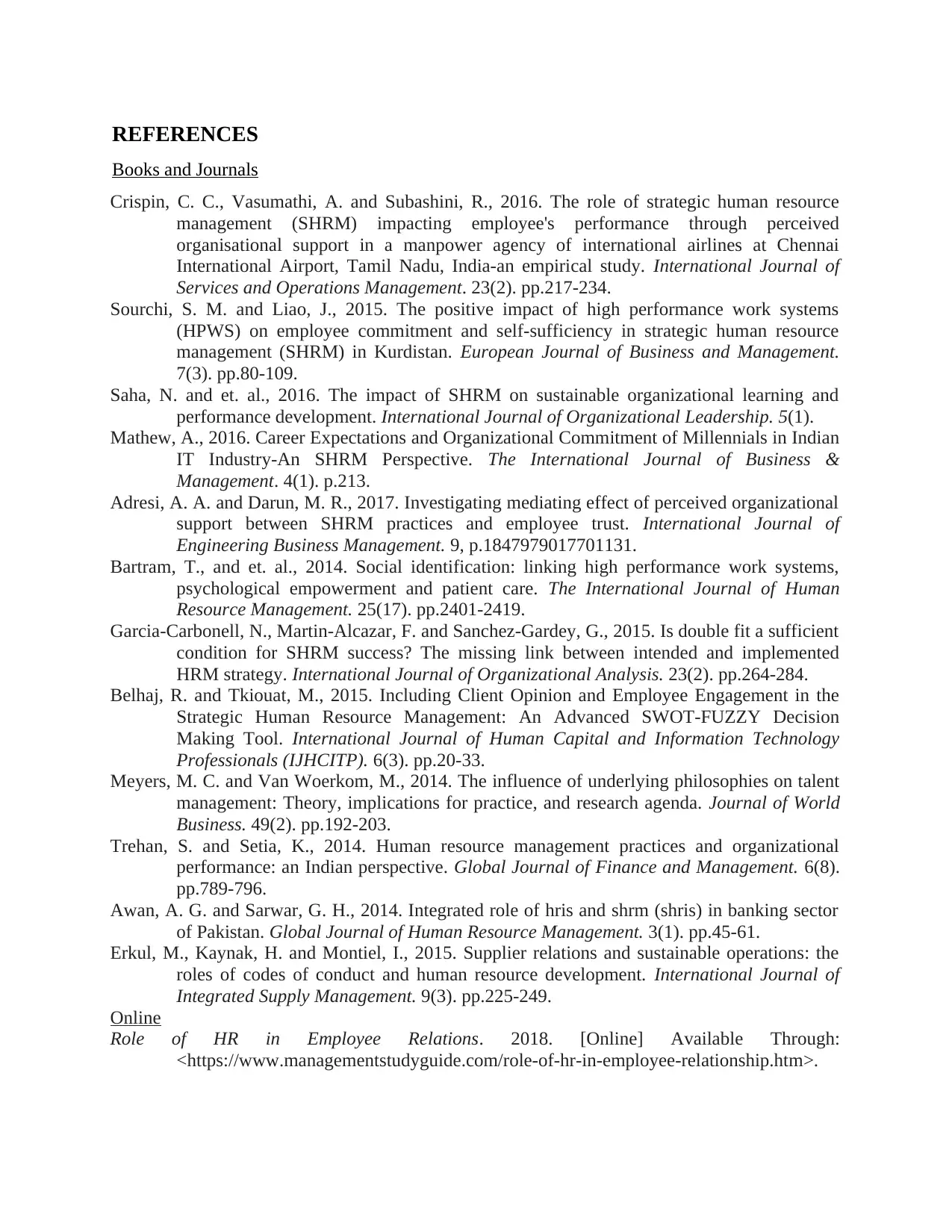
REFERENCES
Books and Journals
Crispin, C. C., Vasumathi, A. and Subashini, R., 2016. The role of strategic human resource
management (SHRM) impacting employee's performance through perceived
organisational support in a manpower agency of international airlines at Chennai
International Airport, Tamil Nadu, India-an empirical study. International Journal of
Services and Operations Management. 23(2). pp.217-234.
Sourchi, S. M. and Liao, J., 2015. The positive impact of high performance work systems
(HPWS) on employee commitment and self-sufficiency in strategic human resource
management (SHRM) in Kurdistan. European Journal of Business and Management.
7(3). pp.80-109.
Saha, N. and et. al., 2016. The impact of SHRM on sustainable organizational learning and
performance development. International Journal of Organizational Leadership. 5(1).
Mathew, A., 2016. Career Expectations and Organizational Commitment of Millennials in Indian
IT Industry-An SHRM Perspective. The International Journal of Business &
Management. 4(1). p.213.
Adresi, A. A. and Darun, M. R., 2017. Investigating mediating effect of perceived organizational
support between SHRM practices and employee trust. International Journal of
Engineering Business Management. 9, p.1847979017701131.
Bartram, T., and et. al., 2014. Social identification: linking high performance work systems,
psychological empowerment and patient care. The International Journal of Human
Resource Management. 25(17). pp.2401-2419.
Garcia-Carbonell, N., Martin-Alcazar, F. and Sanchez-Gardey, G., 2015. Is double fit a sufficient
condition for SHRM success? The missing link between intended and implemented
HRM strategy. International Journal of Organizational Analysis. 23(2). pp.264-284.
Belhaj, R. and Tkiouat, M., 2015. Including Client Opinion and Employee Engagement in the
Strategic Human Resource Management: An Advanced SWOT-FUZZY Decision
Making Tool. International Journal of Human Capital and Information Technology
Professionals (IJHCITP). 6(3). pp.20-33.
Meyers, M. C. and Van Woerkom, M., 2014. The influence of underlying philosophies on talent
management: Theory, implications for practice, and research agenda. Journal of World
Business. 49(2). pp.192-203.
Trehan, S. and Setia, K., 2014. Human resource management practices and organizational
performance: an Indian perspective. Global Journal of Finance and Management. 6(8).
pp.789-796.
Awan, A. G. and Sarwar, G. H., 2014. Integrated role of hris and shrm (shris) in banking sector
of Pakistan. Global Journal of Human Resource Management. 3(1). pp.45-61.
Erkul, M., Kaynak, H. and Montiel, I., 2015. Supplier relations and sustainable operations: the
roles of codes of conduct and human resource development. International Journal of
Integrated Supply Management. 9(3). pp.225-249.
Online
Role of HR in Employee Relations. 2018. [Online] Available Through:
<https://www.managementstudyguide.com/role-of-hr-in-employee-relationship.htm>.
Books and Journals
Crispin, C. C., Vasumathi, A. and Subashini, R., 2016. The role of strategic human resource
management (SHRM) impacting employee's performance through perceived
organisational support in a manpower agency of international airlines at Chennai
International Airport, Tamil Nadu, India-an empirical study. International Journal of
Services and Operations Management. 23(2). pp.217-234.
Sourchi, S. M. and Liao, J., 2015. The positive impact of high performance work systems
(HPWS) on employee commitment and self-sufficiency in strategic human resource
management (SHRM) in Kurdistan. European Journal of Business and Management.
7(3). pp.80-109.
Saha, N. and et. al., 2016. The impact of SHRM on sustainable organizational learning and
performance development. International Journal of Organizational Leadership. 5(1).
Mathew, A., 2016. Career Expectations and Organizational Commitment of Millennials in Indian
IT Industry-An SHRM Perspective. The International Journal of Business &
Management. 4(1). p.213.
Adresi, A. A. and Darun, M. R., 2017. Investigating mediating effect of perceived organizational
support between SHRM practices and employee trust. International Journal of
Engineering Business Management. 9, p.1847979017701131.
Bartram, T., and et. al., 2014. Social identification: linking high performance work systems,
psychological empowerment and patient care. The International Journal of Human
Resource Management. 25(17). pp.2401-2419.
Garcia-Carbonell, N., Martin-Alcazar, F. and Sanchez-Gardey, G., 2015. Is double fit a sufficient
condition for SHRM success? The missing link between intended and implemented
HRM strategy. International Journal of Organizational Analysis. 23(2). pp.264-284.
Belhaj, R. and Tkiouat, M., 2015. Including Client Opinion and Employee Engagement in the
Strategic Human Resource Management: An Advanced SWOT-FUZZY Decision
Making Tool. International Journal of Human Capital and Information Technology
Professionals (IJHCITP). 6(3). pp.20-33.
Meyers, M. C. and Van Woerkom, M., 2014. The influence of underlying philosophies on talent
management: Theory, implications for practice, and research agenda. Journal of World
Business. 49(2). pp.192-203.
Trehan, S. and Setia, K., 2014. Human resource management practices and organizational
performance: an Indian perspective. Global Journal of Finance and Management. 6(8).
pp.789-796.
Awan, A. G. and Sarwar, G. H., 2014. Integrated role of hris and shrm (shris) in banking sector
of Pakistan. Global Journal of Human Resource Management. 3(1). pp.45-61.
Erkul, M., Kaynak, H. and Montiel, I., 2015. Supplier relations and sustainable operations: the
roles of codes of conduct and human resource development. International Journal of
Integrated Supply Management. 9(3). pp.225-249.
Online
Role of HR in Employee Relations. 2018. [Online] Available Through:
<https://www.managementstudyguide.com/role-of-hr-in-employee-relationship.htm>.
⊘ This is a preview!⊘
Do you want full access?
Subscribe today to unlock all pages.

Trusted by 1+ million students worldwide
1 out of 13
Related Documents
Your All-in-One AI-Powered Toolkit for Academic Success.
+13062052269
info@desklib.com
Available 24*7 on WhatsApp / Email
![[object Object]](/_next/static/media/star-bottom.7253800d.svg)
Unlock your academic potential
Copyright © 2020–2025 A2Z Services. All Rights Reserved. Developed and managed by ZUCOL.





